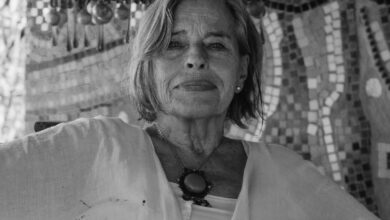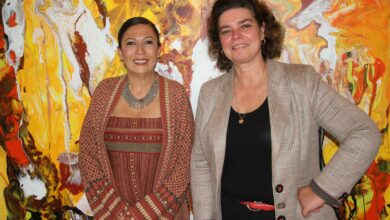Documenta, the brainchild of German painter Arnold Bode, is a mega contemporary art exhibition held in Kassel, Germany every five years since 1955, with a worldwide reputation for challenging prevalent artistic discourses as well as curatorial and exhibition practices.
Last December, inspired by the legacy of Documenta, 25 young Egyptian artists organized an “independent” uncurated exhibition in Cairo’s Viennoise Hotel, to run in parallel with the 12th International Cairo Biennale.
The result, Cairo Documenta, was produced with no institutional support apart from the exhibition space, which was provided by al-Ismailiya Company–a real estate company that has been acquiring Downtown buildings over the past few years.
Printed in a DIY newspaper style, the rebellious manifesto proposed an alternative model for exhibition design, one that is free from the conditions and frameworks imposed by art institutions and practicing curators. Used interchangeably throughout the manifesto, art institutions and curators were described as compromising artwork and reducing it to fit within the hegemonic interpretative frameworks which they advocate.
The idea of Cairo Documenta began in mid 2010, when six artists came together trying to schedule an exhibition during the biennale’s opening week to benefit from the presence of international audience and press. Other artists from the same age group who were active on the local scene were invited to join. The group agreed not to have an exhibition theme, deciding on the title Cairo Documenta which recalls the German project and is meant to “document” the diverse practices of the younger generation of Egyptian artists.
The organization process was organic and collaborative. Artists were only asked to decide on the medium-–drawing, painting, video, installation or performance–and take care of certain logistical assignments. Many were unaware of the projects of other participating artists until the opening night. The purchase of necessary technical equipment was funded through a LE100 participation fee. Hundreds of interested viewers attended the opening, on 13 December 2010.
But Cairo Documenta provided no simple answers to the questions it raised, and the debate within the local art scene is ongoing.
In question, for example, is the notion of “independence.” In the local art scene, “independent” has become synonymous with non-governmental art spaces, like the Townhouse gallery, Contemporary Image Collective and Mashrabia gallery. But Cairo Documeta aimed to cut out the middleman–institutions of all sorts and curators–between the artwork and the audience.
In a Facebook discussion about the exhibition, Alexandria-based curator Bassam el-Baroni argued for the impossibility of independence within the global art scene due to strong commercialization of cultural production. He wrote, “The many paradoxes of the current situation of the arts make the 'independent' a question rather than a descriptive add-on.”
Other curators were critical of the exhibition’s proposition of independence, citing their support from the al-Ismailiya Company. Some also questioned the production conditions–if the artists produced the works on a residency or received curatorial feedback, would that be considered institutional support?
It seems, though, that artists cannot be independent of existing art institutions unless they also operate within them, an approach which the “Cairo Documenta” artists followed even if they do not fully acknowledge it. But perhaps the greatest value in organizing an exhibition with minimal institutional support was to encourage a much needed decentralization of the Egyptian art scene.
Cairo Documenta reduced the role of curators to that of a commissionaire, a gatekeeper or a middleman. The figure of the curator is seen as parasitical, circumventing the agency of the artwork to fit within his or her curatorial vision rather than a collaborator in the process of artistic production and mediation.
In response to the former curatorial model, artist Marwan Fayed presented “Possibilities of Post Curation” on the opening night of Cairo Documenta. Introducing himself as curator Marwan Shoukry, he contrasted the traditional model with a more collaborative curatorial approach, which he dubbed “post curation.” In the latter, artists organize an exhibition on their own. The curator’s role comes later as he or she gathers feedback from participating artists and audiences.The curator then develops a general framework for the show, which he communicates to the public in ways that relate art to their daily lives.
The audience was somewhat confused by Fayed’s presentation. Was it a genuine attempt at democratizing the artistic process or a sarcastic lecture-performance? “Audiences have become used to having a passive voyeuristic role. When an artist demands their active participation they are surprised,” explained Fayed. The low response means that Fayed’s post curatorial project has not yet materialized, but “Possibilities of Post Curation” opened up a conversation about alternative curatorial approaches.
Fayed’s project was kept secret even from other participants until the opening night, but there was still a nice interplay between “Possibilities of Post Curation” and other pieces in Cairo Documenta. Mohamed Allam’s sound installation piece, “You will enjoy a pop song if you listen to it more than five times in more than one place,” distracted from Fayed’s presentation, which was displayed in the same room. Allam has long argued against theoretical framing of artwork, and so the layout worked perfectly. Ahmed al-Shaer’s interactive video game piece “Reissue” also criticized the increased theorising around local contemporary art. In “Reissue,” audience members were asked to destroy “the word concept in English,” which appears at the right side of a computer screen, by aiming a missile at it. The missile as the artist’s statement explains represents the “artwork.” The tension created by the three works–although purely accidental–reflected the multiplicity of views among the participating artists in relation to the mediation of artwork.
Most of the artwork at Cairo Documenta seemed to adopt an activist approach, directly commenting on socio-economic conditions, cultural values and political events. In “Without a Cover Project,” Ibrahim Saad projected two short documentaries from Iraq and Egypt in a restroom. In the first, a US soldier was shown covering the head of Saddam Hussein’s statue at Fardous square with an American flag during the 2003 US invasion. In the second, Egyptian football fans covered the face of novelist Naguib Mahfouz’s statue in Cairo with the Egyptian flag after the national team lost to Algeria. News headlines about poverty, illiteracy and economic crisis in Egypt under President Hosni Mubarak’s reign appeared at the bottom of the screens. Saad, who previously used more abstract and metaphorical visual language, said, “Accessibility of the artwork to the public is key to me. This is why I am starting to use highly recognizable symbols in my work that involves social and political commentary.”
Jasmina Metwaly was one of the few artists who opted for a more subtle approach. In her site-specific installation “Remarks on Color: yellow version,” projected in the stairwell, Metwaly created an unreal “third world.” In the “video painting,” a spider climbs up and down the screen, behind which the artist appears wrapped in yellow silk cloth on a building rooftop surrounded by satellite dishes. She twirls slowly before disappearing in an elevator shaft leaving nothing behind but the yellow cloth. “Remarks on Color: Yellow version” is about the process of acquiring information symbolized by color. Metwaly places recognizable objects like the spider in unfamiliar settings, encouraging her audience to abstain from common associations with these objects and develop different interpretations.
Cairo Documenta closed on 28 December 2010 with mixed reviews as many critics and audience members were excited more by the exhibition's proposition than the actual artwork. Nevertheless, discussions of the issues it raised continue in the local art scene whether in private conversations or directly with the participating artists. Several institutions and curators are contacting them trying to capitalize on the heightened interest in Cairo Documenta’s model and a possible second edition. The artists, however, repeatedly confirm that any following exhibition will continue to advocate their model of “independence.”
Cairo Documenta was held at the Viennoise Hotel from 13 to 28 December 2010. The participating artists were: Mohamed Abdelkarim, Amr Ali, Mohamed Allam, Ahmed Badry, Ahmed Basiony, Ahmed El Shaer, Amr Elkafrawy, Asmaa Elkolaly, Hend Elkolaly, Marwa Elshazly, Marwan Fayed, Ganzeer, Mahmoud Hallwy, Mahmoud Hamdi, Hossam Hodhod, Ahmed Kamel, Kareem Lotfy, Jasmina Metwaly, Magdi Mostafa, Ahmed Nagy, Ibrahim Saad, Ola Saad, Ahmed Sabry, Sarah Samy and Ahmed Talal.




